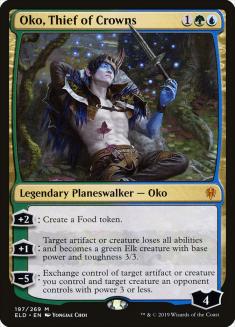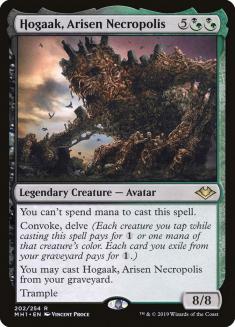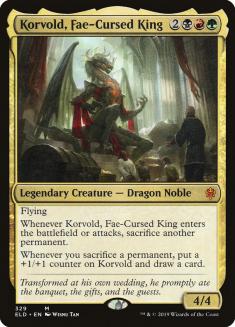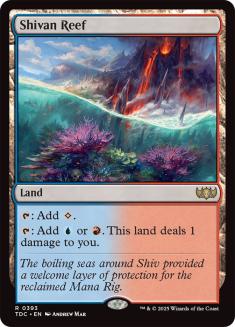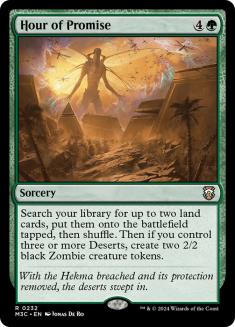It doesn’t seem to make any sense.
Last Monday, Wizards of the Coast banned Oko, Thief of Crowns in Standard. Up until that point, it was the most-played mythic rare in the format by a vast margin. If you weren’t running four copies of Oko in your Standard deck, it was probably because you were sick of seeing Elk tokens in your dreams and wanted to play something else in protest.
So why did Oko start to surge in price right after it was banned? And what does that tell us about Oko’s future price tag, as well as the proper action to take next time a crucial card is banned in Standard? Was Oko a unique case, or is this indicative of some larger trend in the marketplace? Let’s find out.
Factor #1: The Oko Ban Was Obvious
Everybody knew that Oko, Thief of Crowns was going to be banned in Standard. I figured there was a very small chance they might try to ban around Oko in order to preserve their marquee planeswalker’s playability, but after the Hogaak debacle this summer and the Golos banning in September, I was pretty sure they were going to go for the jugular.
I wasn’t alone in feeling this way. Almost everyone I talked to in the weeks leading up to the Oko ban saw the writing on the wall, which was reflected in Oko’s price tag. After peaking around $70 in the third week of October, the planeswalker lost roughly 50% of its value over the ensuing weeks. By the time WotC posted their Banned and Restricted announcement, Oko was worth just $35 – something of a bargain, considering how much play it was seeing in Standard.
Granted, not all that lost value was due to the B&R talk. Fall set staples almost always lose value during the month of November as more people draft the set and the overall market supply increases. But if there was no ban risk with Oko, his price tag certainly would have been higher than $35. It would have been $50 at least, if not $60. Instead, the risk of an Oko ban was (correctly) valued into his price tag.
Factor #2: Everybody “Knows” That Cards Drop in Price After Being Banned
Let’s talk about Hogaak, Arisen Necropolis – another card whose banning was easy to predict.
Hogaak peaked close to $30 shortly after Modern Horizons was released, but it quickly became clear that the card was not long for Modern. WotC tried to ban around Hogaak at first, and after it was clear that they’d failed, we all just had to sit around and wait for Hogaak to get the axe. By the time Hogaak was finally banned, his retail price was just $6 – an 80% loss in value before the B&R decision was even published.
Unlike Oko, Hogaak did not go up in price after it was banned. Instead, it just kept falling. The current Star City Games retail price for Hogaak is just $0.75, meaning that the card is now worth just a tiny fraction of what it was worth in June. Heck, even just a collapse from $6 to $0.75 is significant – that’s more than an 87% tumble in price, albeit on a smaller scale. If you were hoping to buy into Hogaak for your Legacy or Commander deck, waiting until well after the banning was clearly the right move.
Factor #3: Oko Sees a Lot of Play in Pioneer, Modern, and Commander
This is where the biggest difference between Oko and Hogaak becomes pretty obvious.
Right now, there are four major Magic markets that drive prices: Standard, Pioneer, Modern, and Commander. Hogaak was never eligible for play in Standard or Pioneer, and it was banned in Modern. It sees a little bit of play in Commander, but it’s not a clear-cut format staple.
Hogaak does see some play in Vintage and Legacy, but those formats don’t really affect prices outside of a few super-expensive Reserved List cards. When you have to own The Tabernacle at Pendrell Vale to play a deck in Legacy, getting a few copies of Hogaak to round out your 75 becomes trivial. This has always been true with Legacy and Vintage, but things are trending even more in that direction now that those formats have left the main stage spotlight. You can’t count on Legacy or Vintage playability to boost the price tag of any card that isn’t already incredibly scarce, and Hogaak isn’t incredibly scarce.
Creatures (12)
Planeswalkers (7)
Lands (19)
Spells (22)

On the other hand, Oko is still playable in three of the four major formats. The powerful planeswalker has been thriving in both Pioneer and Modern lately, and it’s one of the better utility cards in Commander. Thousands of Magic players still need copies of Oko for these formats, which simply wasn’t true for Hogaak. Thus, demand for Oko stayed high.
Factor #4: Oko Survived a Round of Modern and Pioneer Bannings
On the same day that Oko was banned in Standard, Oko was emphatically not banned in either Modern or Pioneer.
The Simic planeswalker doesn’t seem to be a major problem in either of these formats yet, but Oko is certainly making its presence known in both Modern and Pioneer, and I can imagine a world in which WotC might want to make Oko go away before it could warp yet another format.
In particular, I think a lot of people were holding off on their Oko decision until after the Pioneer announcement on Monday afternoon. When WotC announced that they would not only be holding off on bans this week but next week as well, folks took that as a green light to buy Oko for their Pioneer decks. After all, it had just been banned in Standard, so the price should be dropping just like Hogaak – right?
Factor #5: All Press Is Good Press
What percentage of all Magic-related conversations over the past few weeks do you think have been at least nominally about Oko? It has to be almost half, right? I haven’t written an article since Oko was previewed that hasn’t at least mentioned the planeswalker. If it hadn’t been for the launch of Pioneer (a format that also includes Oko!), we’d have been talking about nothing else for months now.
Creatures (25)
- 4 Llanowar Elves
- 4 Elvish Mystic
- 2 Rhonas the Indomitable
- 4 Steel Leaf Champion
- 4 Lovestruck Beast
- 3 Questing Beast
- 2 Yorvo, Lord of Garenbrig
- 2 Brazen Borrower
Planeswalkers (6)
Lands (21)
Spells (8)

Granted, a lot of those conversations can be summed up as “Oko is too powerful, and that isn’t very much fun,” but that doesn’t really matter. Oko has been on everybody’s mind all season, and that has certainly created demand for the card that wouldn’t exist otherwise. This is especially true in casual spaces, where folks who don’t play much Standard are eager to get a taste of Oko’s power level for their Commander decks. After all, they’ve been hearing about nothing else for months!
Putting It All Together
Most cards that are obvious ban targets drop in price as the inevitable ban approaches. Oko was no exception. Players generally don’t want to invest a lot of money into cards that they won’t be able to use for very long, so the casually competitive Standard crowd shied away from picking up Oko. It wasn’t unreasonable to think that the card would continue to drop in price post-ban as well, because that’s what usually happens when a card is banned. Also, there was a very real chance that Oko would be banned in either Modern or Pioneer in addition to Standard.
As it turns out, Oko’s price was also dropping because a lot of Modern, Commander, and Pioneer players were holding off on acquiring their copies until after the ban. Everyone had the same idea to wait it out, in hopes of snagging their copies at a lower price point. Once it was clear that Oko would be banned in Standard but not in Modern or Pioneer, hundreds of folks were given the green light to buy in. As a result, demand spiked – and so did Oko’s price tag.
What Happens Now?
If you look at the price charts, it appears as though Oko’s resurgence peaked toward the middle of last week. Its price tag appears to be trending downward again, though not very quickly. As of the writing of this article, Oko has a Star City Games retail price of $50 – about $15 more than it was pre-ban, and about $5 less than it was at last week.
It’s tempting to say that Oko will be fairly stable in the $50 range since it does see a lot of play in Pioneer and Modern, but that would be relatively unprecedented for a current-set card that can’t actually be played in Standard. Standard might just be one of the four big formats where Oko sees play, but losing that avenue of playability is still a pretty huge deal. There are loads of players who only play Standard, and plenty of other folks who purchased four copies of Oko for their Standard deck but aren’t interested in playing Simic in Pioneer or Modern. Some of these folks will sock their Okos away in trade binders, but many of them will trade or sell their copies of the card as soon as there’s something else they want.
We also haven’t hit peak supply for Throne of Eldraine yet. The fall set is generally the best-selling set of the year, not only because it headlines each new post-rotation format but because it has the longest draft season of the year. Throne might be old news for those of us who are really plugged into the Magic scene, but it’s still going to be drafted a few dozen times at your LGS this week, and thousands of boosters will be given out as holiday gifts over the next couple of months. The Okos are still coming.
I’d also be surprised if Oko doesn’t drop in price as the eyes of the community move toward the latest shiny new object. The less we talk about Oko, the less demand there’s going to be. In addition, folks will need to raise money for whatever the hot new deck is – and when they do, selling their expensive, recently banned planeswalker is going to look like a pretty sweet deal.
I also wouldn’t be shocked if Oko is banned in at least one eternal format at some point over the next several months. Remember: WotC still wants to sell packs of Throne, and the fact that you can still play Oko in Pioneer and Modern has prevented folks from complaining that their brand-new chase card is suddenly worthless. Don’t get me wrong, WotC would ban Oko in those formats tomorrow if it were absolutely necessary, but this is an added incentive for them to keep Oko around in Pioneer and Modern for now. Once there’s a new set to get excited about, it won’t be as big a marketing blow if they do decide to ban Oko in an eternal format or two.
Ultimately, I expect Oko’s price to continue slowly eroding. This trend will reverse itself and Oko will spike if a deck like Simic Aggro or Temur Midrange ends up surging in popularity in Pioneer, but that’s also the scenario that’s most likely to lead to a banning. Otherwise, I expect Oko to end 2019 below its pre-ban price tag of $35. If you’re looking to pick up a personal copy or four, I’d hold off until late December.
Korvold, Fae-Cursed King: The Highest Ceiling in Standard
The card that spiked the highest this week was Oko, Thief of Crowns. In second place? Korvold, Fae-Cursed King.
The reason for this is excitement over Jund Sacrifice, which has emerged from the ashes of the Standard bannings as one of the strongest potential decks in the format. Now that Oko is gone, the Cauldron Familiar / Witch’s Oven combo has begun to show its true power in the Standard metagame. Jeskai Fires is still probably the strongest and most popular deck, but the various iterations of the Familiar/Oven combo are almost certainly sitting in second place.
For your Korvold spec to pay off, you’ve essentially got to hope for three different things to happen:
1. The Familiar/Oven combo has to be good in Standard. We can check this one off the list—done and done.
2. Jund Sacrifice has to become one of the better shells for the Familiar/Oven combo. Right now, it’s competing with a Rakdos, a Sultai, and a Golgari version for dominance in the metagame. The Rakdos version is currently more popular on MTGO, but the Jund version was the most-played variant in Twitch Rivals last week as well as the second-place finisher. Brad Nelson also seems to really like it.
Personally, I find the Jund variant to be leagues better than either the Golgari or the Sultai version. And even if the Rakdos shell remains popular, I expect that Jund Sacrifice will continue to be a part of the metagame going forward as well. We can’t check this one off our list with the same easy flourish, but things are looking good.
3. The best version of Jund Sacrifice actually has to run Korvold, Fae-Cursed King. This is where things get a bit iffy for me. The version of Jund Sacrifice that Matheus Yanaguira piloted to that aforementioned second-place finish in Twitch Rivals ran zero copies of Korvold, and it’s possible that the best version of this deck only wants to dip into red for Mayhem Devil and the sideboard Cindervines. If Korvold isn’t an essential part of Jund Sacrifice, it doesn’t matter how much play the deck sees – your spec will bust.
That said, Korvold has the highest financial upside of any card in Standard right now. As you are probably aware, Korvold isn’t a normal Throne of Eldrane mythic rare – it’s one of the Brawl precon Commanders. That means it’s only available in the Brawl decks (foil only) or in Collector Boosters. If Korvold becomes a four-of in one of the best decks in Standard, it will likely become the most expensive card in the format.
I don’t have any data on how scarce the Brawl mythics are compared to normal Standard-legal mythics, but the perception of scarcity has already caused Korvold to spike once. The card jumped $20 last week just on the off-chance that it might end up becoming a key part of a Standard deck, and that wouldn’t have happened if it were a regular mythic. This could be similar to Nexus of Fate, where the perception of scarcity caused the card to hit $50 despite WotC later telling us that there were more copies of Nexus on the market than any other Core Set 2019 mythic.
If you bought into Korvold back when it was $8-$10, you should probably just sell now and lock in those gains. Standard cards rarely jump from $10 to $30 in the course of a week and selling into the hype is almost never wrong. Just be aware that if a build of Jund Sacrifice running Korvold takes down a tournament or two over the next couple of weeks, we’re looking at a $40-$50 card. Last week’s spike may have just been the start.
This Week’s Trends
After taking down the Season Two Invitational at SCG CON Winter, Mono-Black Aggro became the hot new deck in Pioneer. As a result, many of these cards have seen their financial fortunes improve over the past several days:
Creatures (24)
- 4 Bloodsoaked Champion
- 4 Scrapheap Scrounger
- 4 Night Market Lookout
- 1 Gutterbones
- 4 Knight of the Ebon Legion
- 3 Rankle, Master of Pranks
- 4 Murderous Rider
Lands (24)
Spells (12)

So far, the biggest Mono-Black spikes belong to Mutavault; Kalitas, Traitor of Ghet; and Bloodsoaked Champion. I’m a little iffy on Kalitas since it’s just a sideboard one-of in this deck, but Mutavault has proven itself clutch in multiple decks all over Pioneer and I expect it to continue gaining ground. As for Bloodsoaked Champion, this card was a bulk rare as recently as last week. It’s definitely time to fish some copies out of your bulk bins and keep an eye out in your local store’s box of chaff. The card is a key part of what Mono-Black Aggro is trying to do in Modern, and it’s going to keep seeing play as long as this deck is viable.
Also up this week: Shivan Reef, which sees play in all of Pioneer’s good Izzet and Jeskai decks. This card has been slowly ticking up in price since Pioneer’s inception, but it really took off on Thursday and Friday of last week. The underlying metrics are solid, but I still smell a buyout. The Apocalypse version sold out everywhere before the Magic Origins version was even touched, telling me that someone (or some group) may have been methodically snapping these up.
The buyout folks picked a solid target for their buyout – the card sees a ton of play in Pioneer, and casual demand should backstop its price somewhat – but be aware that buyout spikes tend to climb fast and drop hard. If you’ve got any extra Reefs, now is a great time to sell. If you’re hoping to pick them up, try to wait at least a week or two for the price to stabilize.
Also up in Pioneer this week: Supreme Verdict, Nicol Bolas, the Ravager, Hour of Promise, and Archangel Avacyn. In all four cases, these cards appear to be finding successful niches in popular Pioneer decks. Their growth has been fairly authentic, and I suspect they aren’t done gaining in price. If you need them, you can pick them up with confidence.
Over in Modern, the overall index is still down. Other than an almost statistically meaningless price increase from Chalice of the Void, I can’t find a non-Pioneer Modern card that’s on the rise right now. My personal card sales tell the same story, as very few of my Modern cards are moving right now while my Pioneer and Commander staples are still doing incredibly well.
Is this…drumroll…the death of Modern?! No. There’s just no real reason to focus on Modern right now with a brand-new Standard format to play with and Pioneer still in the early stages of development. Even the most die-hard Modern players I know are busy with those other formats right now.
I expect that Modern will rebound in January or February like it always does. There will be loads of high-profile Modern events (and probably some bannings!) in 2020 that will cause the market to surge, likely for large swaths of the calendar. So with demand soft and prices even softer, now is a good time to start buying and trading for whatever Modern staples you think you’ll need next year. Modern Horizons cards seem like especially good pick-ups to me, with many of the Horizon lands at or near their historic low prices and Wrenn and Six falling in price after the Legacy ban. One of the keys to Magic Finance is to zig when everyone else is zagging, and that means looking at Modern over the next month or two.
Lastly, it looks like WotC is announcing yet another new product this week: Secret Lair. The full announcement will come later today, possibly by the time you’re reading this, so I don’t see any use in speculating on it here. If Secret Lair ends up being a financially-relevant product, I’ll discuss it as soon as I can. Fingers crossed it’s something fun and accessible!

